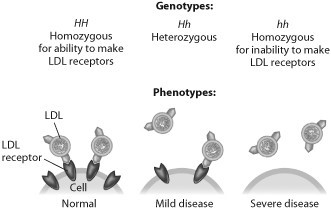Describe the main functions of the four basic tissues.
(a) Epithelial tissue:
(b) Connective tissue:
(c) Muscle tissue:
(d) Nervous tissue:
(a) Epithelial tissue: protection and transport (secretion, absorption, etc.)
(b) Connective tissue: protection, support, storage
(c) Muscle tissue: contraction
(d) Nervous tissue: point-to-point communication
You might also like to view...
A characteristic of a system that does not appear in any of its component parts is called a(n) ________
a. emergent property b. hierarchy of organization c. homeostasis d. adaptation
Acetyl can be a substrate for a number of different reactions involving different enzymes and resulting in different products. This situation can be described as
A. enzymatic inhibition. B. negative-feedback inhibition. C. substrate competition. D. enzymatic competition.
According to this figure, heterozygotes for this form of hypercholesterolemia suffer from the disease because they

A) produce an abnormally shaped LDL receptor.
B) don't produce any LDL receptors.
C) produce too many LDL receptors.
D) don't produce enough LDL receptors.
The (bacilli/Lactobacilli/bacteroids) are a group of Gram-negative bacteria that include obligate anaerobes normally found in the intestinal tracts of animals and humans
What will be an ideal response?